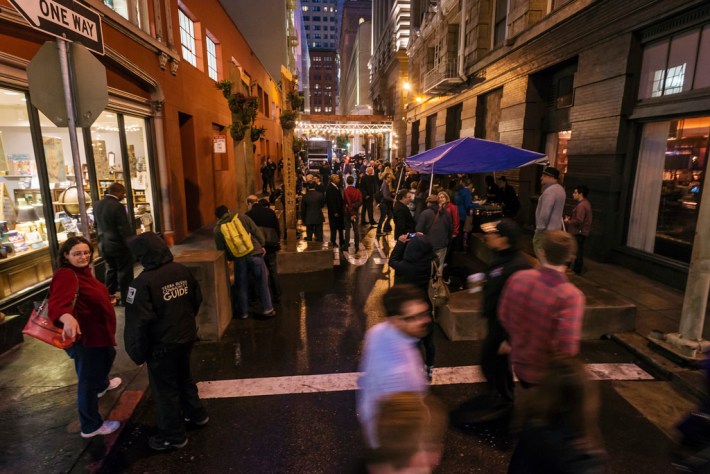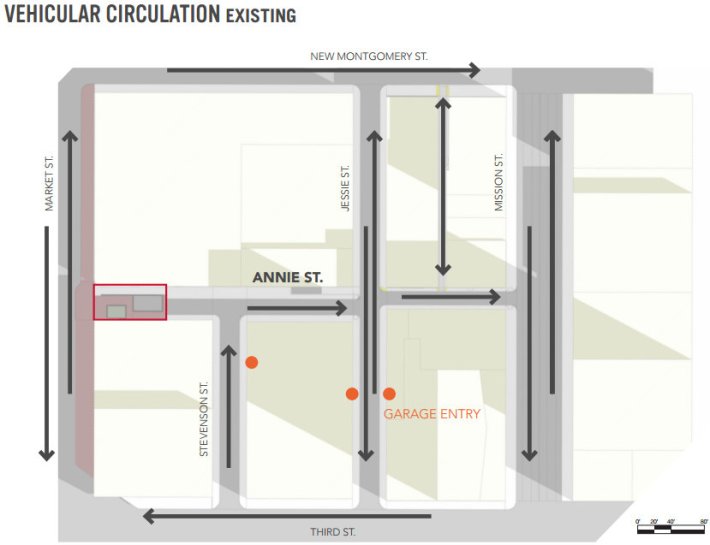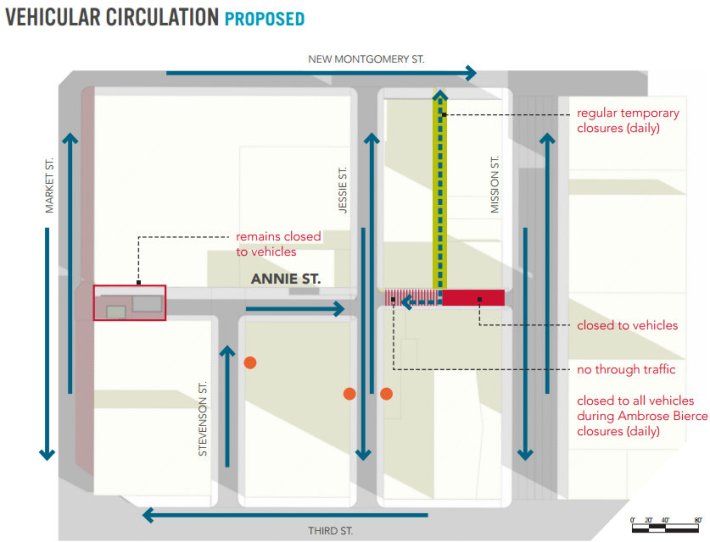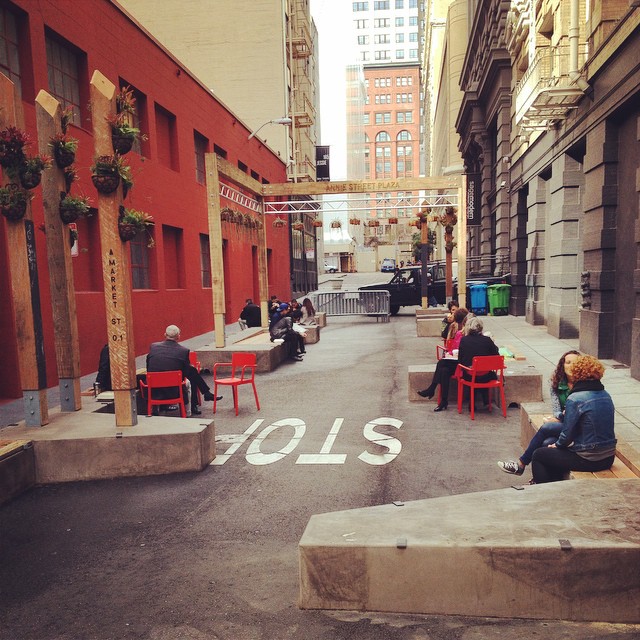Hearst Corp Seeks to Rip Out Annie Alley Plaza to Make Room for Cars
6:21 PM PST on January 9, 2015

The Hearst Corporation filed an appeal last month in an attempt to dismantle the Annie Alley street plaza so drivers exiting its parking garage could take a more direct path to Mission Street.
In November, the alley exit along Mission, between Third and New Montgomery Streets, was turned into a place for gathering and events that opened to popular fanfare. But the pop-up plaza apparently surprised and irked some higher-ups at Hearst with enough pull to hire a lawyer to get it taken out on the company's behalf, even though the company was involved in creating the plaza.
A hearing for the appeal is scheduled at the Board of Permit Appeals on February 11.
Representatives from Hearst were involved in the planning for the plaza, which lasted two years, and even hosted a small meeting of local property managers for it. The media conglomerate is a major real estate owner in the Yerba Buena neighborhood of SoMa, and the parking garage exit for its Hearst Building is on the alley Jessie Street, which intersects Annie at the corner next to the street plaza. Some drivers apparently were used to turning on Annie to go westbound on Mission.
In a December 17 letter [PDF] addressed to Stephen Hearst, vice president and general manager of Hearst's Western Properties, John Elberling of the Yerba Buena Neighborhood Consortium wrote that "we are appalled by the gigantic Hearst Corporation’s blindside attack on this tiny but heartfelt Yerba Buena community improvement project."
The Yerba Buena Community Benefit District built this very, very modest Neighborhood public space at its own cost as a new amenity for all of us that live, work, or visit our Yerba Buena Neighborhood. The project went through a very public and open community design process over two years. Representatives of the Hearst Corporation, as adjacent property owners, were specifically included in that process. Then it went through a rigorous City permitting process without objection by the Hearst Corporation.
But now that Annie Alley Plaza is open, completed in November, suddenly the Hearst Corporation has filed an appeal with the City Board of Permit Appeals seeking to invalidate those permits and force its immediate demolition!
The appeal, Elberling wrote, appears to be "the naked intimidation tactics of a gigantic corporate bully against our small Yerba Buena/ SOMA community."
It's possible the appeal will be dropped before the hearing. Hearst is reportedly in talks with the Yerba Buena Community Benefit District and other players at City Hall to rescind it. The YBCD led the planning process and paid for most of the plaza's costs, facilitated by the Planning Department's Pavement to Parks program.
Andrew Robinson of YBCBD would not comment on the status of the appeal, but said the organization is "hopeful that a resolution will occur in the next week or so."
During the planning process, Hearst representatives had been informed that traffic counts would be taken during the two-year trial period and compared against those taken in 2013, both when Annie was open to cars and during trial car closures for events.


So how many more cars were on Jessie when drivers had to travel another half-block instead of turning on Annie? According to a memo on the study [PDF], the evening rush hour saw one additional westbound vehicle per minute on Jessie, and one additional eastbound vehicle every four minutes.
But Hearst's appeal [PDF] insists that "vehicles routinely line up bumper-to-bumper on Jessie Street" since "Annie Street is no longer available as an escape valve." In an SF Weekly article, reporter Joe Eskenazi described watching a driver take 90 seconds to exit the alley.
Marty Cepkauskas, director of real estate for Hearst Western Properties, told Streetsblog the effects of the plaza are "dangerous" for pedestrians.
"While the Hearst Corporation supports open space, the Annie Street closure as part of the pilot plaza program has generated unintended and dangerous consequences in an already congested neighborhood," said Cepkauskas. "The actual traffic impact in the immediate vicinity has been much greater than forecasted by the preliminary traffic study, and everyone is very concerned about the traffic and pedestrian safety issues caused as a result of this street closure, especially during rush hour."
"Hearst, along with other property owners and stakeholders, have already met with city officials who have acknowledged these traffic and pedestrian safety problems. Hearst is committed to continuing to work with all stakeholders to find short and long-term solutions."
The Hearst appeal makes three arguments, which project planners say are plainly invalid. Two of the points claim that the project didn't adhere to the permitting standards set for permanent plazas, even though Annie Alley is run under a separate process for temporary plazas, which are installed using removable materials and require further approvals to become permanent.
"It really doesn't have anything to do with Annie Alley," said Robin Abad Ocubillo, project manager for the Planning Department's Pavement to Parks program. "It's always been communicated to the public and to the city that it's a temporary demonstration closure to allow everyone to observe what Annie could be like if it were converted from a use other than for cars."
Hearst's third claim is simply that the traffic counts analyzed by Nelson/Nygaard, a highly-respected transportation consulting firm, were poorly done. Ocubillo said the results were done using "standard methodologies" and vetted under the CA Environmental Quality Act.
"We went out at the right times, the right days, to collect traffic data in the correct manner, and will continue to do that moving forward," said Ocubillo.

What's clear is that the alley now serves as a popular public space in a dense downtown neighborhood. Even the Hearst-owned SF Chronicle stated in its headline on a column from John King: "SF’s newest public space provides invitation to sit, linger."
"The community fought for every last inch of public open space in this district which has so litte," said D6 Supervisor Jane Kim, who recently filmed a PSA for the Pavement to Parks program on Annie Alley plaza. "It's amazing seeing the community realize a project that will hopefully be a model for the rest of the city."
"We need more Annie Alleys," she said.
"Annie Alley represents such a wonderful partnership between property owners, institutions, businesses and residents in the neighborhood," said Ocubillo. "It's our collective hope that the Hearst Corporation continues with us in that partnership, as they did when participating in all the public meetings leading up to installation. Let’s give Annie Street a chance to show what value it can provide to this neighborhood!"
Stay in touch
Sign up for our free newsletter



